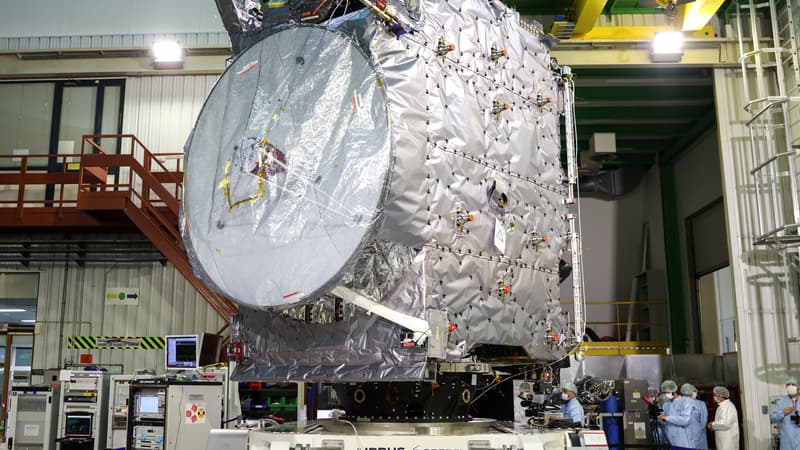Life on Jupiter? This Thursday, the Juice space probe (Jupiter Icy Moons Explorer) of the European Space Agency (Esa) will be launched aboard an Ariane 5 rocket from the Kourou base, in Guyana, towards the planet with the largest gas in our solar system. . .
The objective: to explore the complex environment of Jupiter by studying its three icy moons (Ganymede, Europa and Callisto) with more precision to unveil certain mysteries never clarified during the two previous missions in 1979 (Voyager 1) and in the 1990s (Galileo). .
“The Jupiter system may be an archetype of exoplanets. It is the type of mission that takes a long time to develop but provides extraordinarily essential information”, rejoices with BFMTV.com Athéna Coustenis, a CNRS researcher and member of the mission’s scientific committee.
Hope around frozen moons
After several years of orbiting the Moon and Earth, flying over Venus and traveling hundreds of billions of kilometers, the Juice probe will arrive near Jupiter in 2031. It will then fly over the moon Europa twice, the moon Callisto 21 times, then orbit Ganymede, a first for a moon other than our own.
The vehicle, thanks to ten state-of-the-art scientific instruments, will thus be able to explore the oceans of ice that are hidden inside the only moon in the solar system with a magnetic field. The researchers hope to find evidence of the presence of liquid water, absent on the surface despite encouraging photographs of geysers.
“We are looking for liquid water and a source of energy to have a chemical reaction, such as heat,” two favorable conditions for the emergence of life, Nicolás Altobelli, head of the ‘Isa’ mission, explains to BFMTV.com.
in search of habitability
Although important discoveries are to be made during the Juice mission, the European space probe will not end decades of searching for life in space. The experts are formal, for a technical reason.
The director of the agency’s science center explains: “We are not looking for life, we do not have the instruments. Only the Viking probe, in the 1970s on Martian soil, was equipped with them.”
But, if Juice can’t find traces of life, he is looking for habitable conditions, that is, the favorable conditions for the emergence of life and its development.
“In the coming years, all space missions aim to study habitable conditions, recalls researcher Athéna Coustenis. On Mars, and despite some sixty missions, none have given us signs of life. But this time, we hope to find conditions for the emergence of life.
At present, scientists prefer to warn the public: in no case is it about finding favorable conditions for us to live there as humans. To illustrate this point, Nicolás Altobelli takes the example of the Earth.
“You have to define the notion of habitability. When life appeared on Earth, humans couldn’t live there. Currently, life cannot appear but humans can live there”, says-Vale.
ESA/NASA cooperation
A few hours after its launch, thanks to the last trip of Ariane 5, the mission is one of ESA’s most ambitious projects, a “European pride” according to Athéna Coustenis.
“This shows that we play at the same level as NASA. It is true that the commercial increases in the United States, but in the exploration missions we are on an equal footing, ”she believes.
In addition, competition between agencies should turn into cooperation, since NASA’s Europa Clipper mission, which is scheduled to depart in 2024, will reach Jupiter – and more precisely the moon Europa – in 2030, that is, a year earlier. what juice
“We will be on site at the same time. There will be a kind of coordination. We will take measures together”, continues the CNRS researcher.
Therefore, it will be necessary to wait at least eight years before being able to exploit the first data, which will last until 2035.
“Do not hurry up. Missions to the outer solar system take two generations. Today’s astrophysics students will be in charge of exploiting the work of those who developed the mission”, summarizes Nicolás Altobelli.
Source: BFM TV


